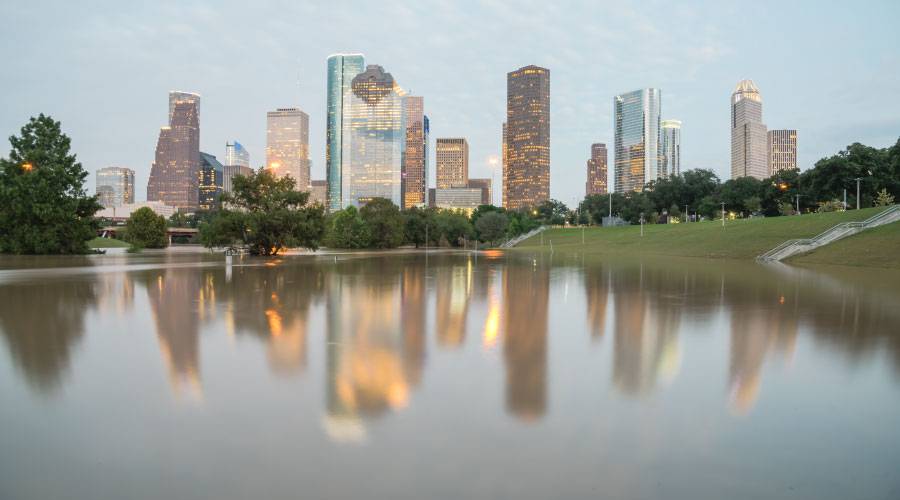3 Ways Sustainability Complements Building Resilience
Part 1 of a 2-part article on understanding the link between sustainability and resilience in energy and water efficiency, building envelope, stormwater, and other areas
For at least the last decade, scientists, economists, activists, and politicians have argued fiercely about how best to spend money to address climate change — should we admit substantial shifts in the climate are inevitable, and sink money into adapting to our new reality? Or should we continue the good fight to reduce emissions with the long-term goal of preventing the worst climate change-related impacts? Most would agree that we should do both adaptation and mitigation, but the battle is fought over the degree to which one is more effective. For facilities, the answer is also both, but it’s a less hotly contested issue. That’s because, in many cases, when you’re working on climate change mitigation (in the form of making buildings sustainable), you are by default also working on adaptation (in the form of resilience). "If you start really thinking about sustainability, you’re going to get pretty far down the road to being resilient," says Jim Newman, founder and principal of Linnean Solutions. In other words, sustainability complements building resilience.
The importance of considering these two concepts in tandem is that doing so adds meat to the argument for making capital improvements to existing buildings that can have cost-savings, sustainability, and resilience benefits. "If you do resilience as a standalone strategy, it can be very expensive," says Cecil Scheib, chief program officer for New York City’s Urban Green. "If you look at sustainability and resilience as a package, it’s much more cost-effective. The time to look at resilience is when you’re doing sustainability capital improvements."
This is a sentiment with which Ellen Vaughan, policy director for sustainable buildings, Environmental and Energy Study Institute, agrees: "The biggest opportunities? Look where there are synergies. Look where you can get the biggest bang for the buck. Look for two-fers."
But resilience and sustainability are not merely conceptually related. What follows is advice from high-level experts on three key areas where resilience and sustainability complement each other, and practical advice on how to implement both together.
Energy Efficiency
This is quite simple: "If you’ve done a good job of looking at energy efficiency, the systems you’re relying on are smaller, and that makes you more resilient," says Brendan Owens, chief of engineering for the U.S. Green Building Council. Those systems range from energy-using systems like HVAC and lighting to emergency power generation systems.
"You can replace heavy cast-iron boilers in the basement with lighter boilers on the roof," Scheib says. "Now the boilers are more resilient, and they’re using way less energy."
Larger organizations with huge, complex facilities and enormous energy demand have figured this out, says Owens. "If you cut energy use by 50 percent, that doubles the time they can run off-grid." Or, if you think about this another way, reducing energy use means smaller back-up generation capacity is necessary, which — if generators are on the verge of needing replacement — can mean a huge capital cost-savings in the form of having to buy less capacity.
"If you’re concerned about backup power, Step 1 is to reduce the amount of energy you’ll need to back up," says Newman. If you’re in a facility that needs to cover 100 percent of the building load, "you better be thinking about how to reduce energy use, otherwise backup power needs are huge," he says.
Furthermore, says Scheib, "backup power runs on the same fuel supply for longer, which has both resilience and sustainability benefits."
This concept of smaller capacity required in energy efficient facilities also applies if you’re considering onsite renewables or cogeneration. The less energy a facility uses, the more resilient it can be in relying on its own energy generation if the grid goes down.
"The intersection of sustainability and resilience in terms of energy efficiency is the self-reliance aspect," says Vaughan. "Microgrids, islanding, low-voltage, and other technologies are providing lots of opportunities to take more control over your environment, to be more self reliant."
Owens agrees: "There’s a trend toward being more self-sufficient, which includes strategies like microgrids, distributed generation, and renewables."
Of course, the bonus with use of renewables and cogen is that not only do they make facilities more resilient and contribute to individual organizations’ sustainability goals, but they also reduce greenhouse gas emissions compared to coal-generated grid electricity. Fewer fossil fuels are burned to power facilities, and on a macro scale, this begins to walk back the worst effects of climate change.
Related Topics:













